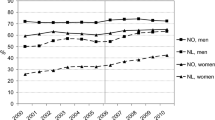Abstract
Since the passage of United States (US)’ Social Security Amendments in 1983, the age for full Social Security benefits has been increasing from age 65 to 67 depending on one’s year of birth. These increases introduce incremental savings in the long-term funding of the US public pension system, but they assume that American workers will be able to continue working past the age of 65. In this study, we examine self-reported work disability for men and women using the 1997 through 2007 National Health Interview Surveys. There are small but significant decreases in work disability and fairly significant increases in labor force activity among men and women in their 60s and for women in their 50s over the 11-year period, and relatively little difference between men’s and women’s trends. Changes in the educational composition of the population play a major explanatory role in the decrease of work disability. Without this compositional shift, work disability would have increased. Increased obesity over this period exerted an opposite effect; without this change, the decrease in work disability would have been greater.


Similar content being viewed by others
References
Alley DE, Chang VW (2007) The changing relationship of obesity and disability, 1988–2004. JAMA 298(17):2020–2027
Alley DE, Crimmins EM (2007) The demography of aging and work. In: Schultz K, Adams G (eds) Aging and work in the 21st century. Lawrence Erlbaum Associates, Mahwah, NJ, pp 7–23
Bhattacharya J, Choudhry K, Lakdawalla D (2008) Chronic disease and severe disability among working-age populations. Med Care 46:92–100
Colvez A, Blanchet M (1981) Disability trends in the United States population 1966–76: analysis of reported causes. Am J Public Health 71:464–471
Crimmins EM, Saito Y (2000) Change in the prevalence of diseases among older Americans, 1984–1994. Demogr Res 3(9):3–9. http://www.demographic-research.org/volumes/vol3/9/3-9.pdf. Accessed 19 Jan 2010
Crimmins EM, Saito Y (2001) Trends in disability-free life expectancy in the United States, 1970–1990: gender, racial, and educational differences. Soc Sci Med 52:1629–1641
Crimmins EM, Saito Y, Ingegneri D (1989) Changes in life expectancy and disability-free life expectancy in the United States. Popul Dev Rev 15(2):235–267
Crimmins EM, Saito Y, Reynolds SL (1997) Further evidence on recent trends in the prevalence and incidence of disability among older Americans from two sources: the LSOA and the NHIS. The Gerontologist 38:578–590
Crimmins EM, Reynolds SL, Saito Y (1999) Trends in health and ability to work among the older working age population. J Gerontol 54B:S1–S10
Cutler DM, Landrum MB, Stewart K (2008) Intensive medical care and cardiovascular diseases disability reductions. In: Cutler DM, Wise DA (eds) Health at older ages: the causes and consequences of declining disability among the elderly. National Bureau of Economic Research, Chicago, pp 191–222
Freedman VA, Martin LG (1999) The role of education in explaining and forecasting trends in functional limitations among older Americans. Demography 36:461–473
Freedman VA, Martin LG (2000) Contribution of chronic conditions to aggregate changes in old-age functioning. Am J Public Health 90:1755–1760
Freedman VA, Martin LG, Schoeni RF (2002) Recent trends in disability and functioning among older adults in the United States: a systematic review. JAMA 288(24):3137–3146
Freedman VA, Crimmins EM, Schoeni RF et al (2004) Resolving inconsistencies in old-age disability trends: report from a technical working group. Demography 41:417–441
Jenkins KR (2004) Obesity’s effects on the onset of functional impairment among older adults. The Gerontologist 44:206–216
Lakdawalla DN, Bhattacharya J, Goldman DP (2004) Are the young becoming more disabled? Health Aff 23(1):168–176
Manton KG, Corder LS, Stallard E (1983) Estimates of change in chronic disability and institutional incidence and prevalence rates in the U.S. elderly population from the 1982, 1984, and 1989 National Long Term Care Survey. J Gerontol Soc Sci 48:S153–S166
Manton KG, Stallard E, Corder L (1995) Changes in morbidity and chronic disability in the U.S. elderly population: evidence from the 1982, 1984, and 1989 National Long Term Care Survey. J Gerontol Soc Sci 50:S194–S204
Manton KG, Corder LS, Stallard E (1997) Chronic disability trends in elderly United States populations: 1982–1994. Proc Natl Acad Sci USA 94:2593–2598
Martin LG, Freedman VA, Schoeni RF, Andreski PM (2009) Health and functioning among baby boomers approaching 60. J Gerontol Soc Sci 64:369–377
National Center for Health Statistics (NCHR) (2009b) 1996-Prior Data and related documentation. http://www.cdc.gov/nchs/nhis/quest_data_related_1996_priora.htm (last updated 10/5/09). Accessed 25 Nov 2009
National Center for Health Statistics (NCHS) (2009a) 1997–2009 Data and related documentation. http://www.cdc.gov/nchs/nhis/quest_data_related_1997_forward.htm (last updated 10/5/09). Accessed 25 Nov 2009
Reynolds SL, Crimmins EM, Saito Y (1998) Cohort differences in disability and disease presence. The Gerontologist 38:578–590
Reynolds SL, Saito Y, Crimmins EM (2005) The impact of obesity on active life expectancy in older American men and women. The Gerontologist 45:438–444
Schoeni RF, Freedman VA, Wallace RB (2001) Persistent, consistent, widespread, and robust? Another look at recent trends in old-age disability. J Gerontol Soc Sci 56:S206–S218
Schoeni RF, Freedman VA, Martin LG (2008) Why is late-life disability declining? Milbank Q 86:47–89
Seeman T, Merkin SS, Crimmins EM, Karlamangla A (2010) Are disability trends worsening among more recent cohorts of older Americans? NHANES 1999–2004 versus 1988–1994. Am J Public Health 100:100–107
Turner JA (2007) Work at older ages: is raising the early retirement age an option for social security reform? CRR WP 2007-13, Center for Retirement Research at Boston College
Verbrugge L (1984) Longer life but worsening health? Trends in health and mortality of middle-aged and older persons. Milbank Meml Q 62:475–517
WHO Expert Consultation (2004) Appropriate body-mass index for Asian populations and its implications for policy and intervention strategies. The Lancet 363:157–163
Author information
Authors and Affiliations
Corresponding author
Additional information
Communicated by Henrik Brønnum-Hansen, Bernard Jeune & Dorly J.H. Deeg.
Rights and permissions
About this article
Cite this article
Reynolds, S.L., Crimmins, E.M. Trends in the ability to work among men and women in the older American population: 1997–2007. Eur J Ageing 7, 249–256 (2010). https://doi.org/10.1007/s10433-010-0166-0
Published:
Issue Date:
DOI: https://doi.org/10.1007/s10433-010-0166-0




